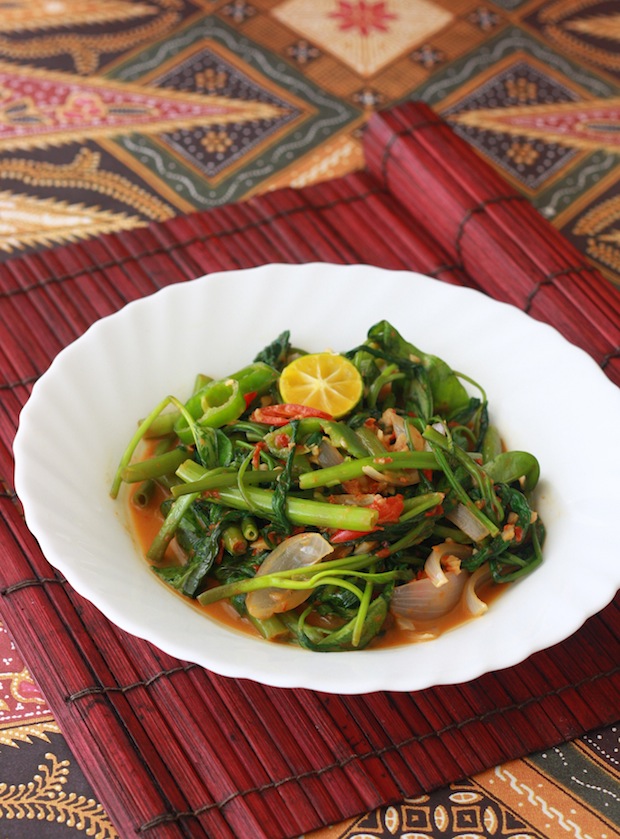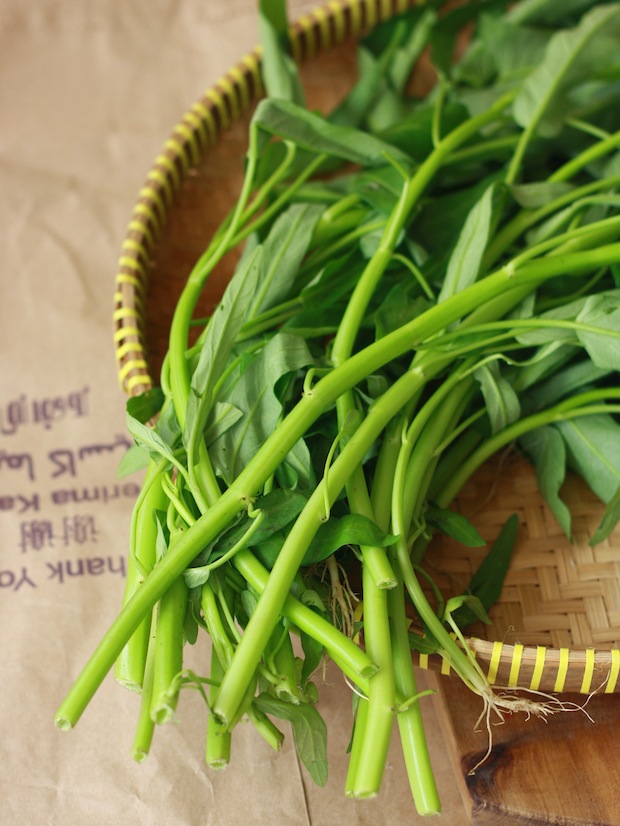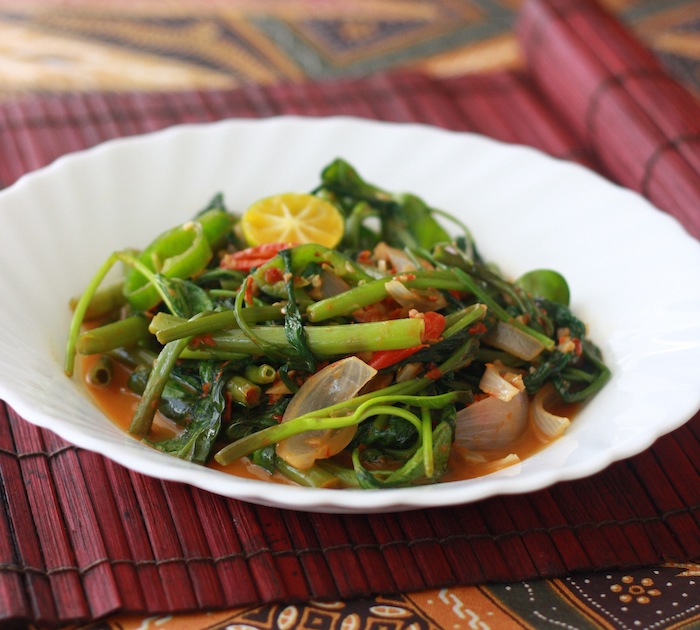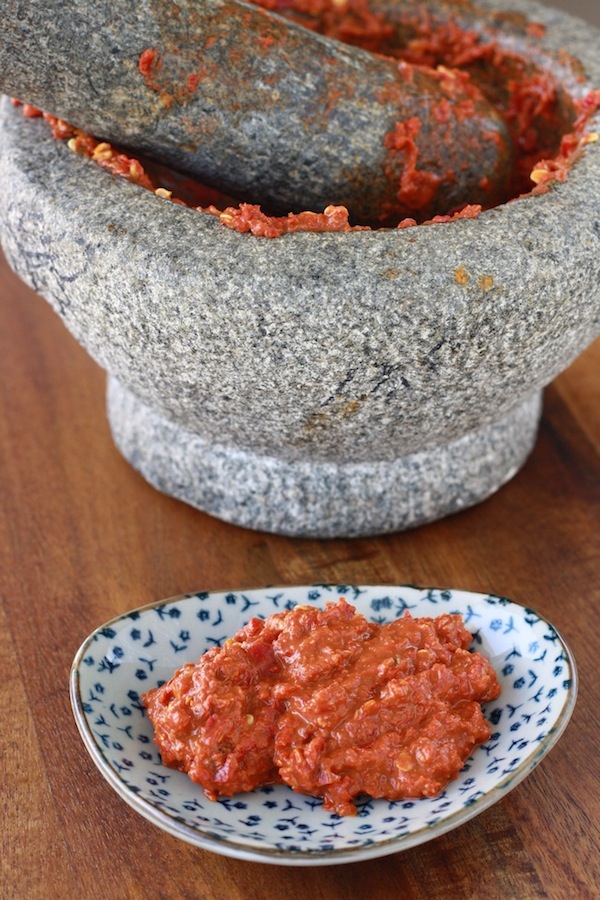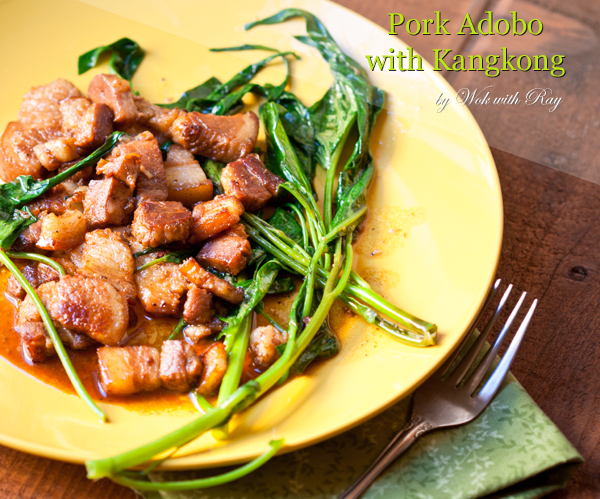Lenggang lenggang kangkung
Kangkung tepi telaga
Lenggang lenggang kangkung
Kangkung tepi telaga
You are meandering with the river, strolling along its bank. A gentle breeze lifts your spirits and sways the leaves of the kangkong plants that float peacefully at the river’s edge.
Balik dari menyabung
Makanlah nasi sahaja
Balik dari menyabung
Makanlah nasi sahaja
A song of village life; of a river that flows calmly in its own wandering way; of a leafy plant that grows wild in the water, softly guided by the wind and by the current.
A folk song we learn in school in Malaysia and Indonesia about the meaning of a much loved vegetable – kangkong.
A folk song we learn in school in Malaysia and Indonesia about the meaning of a much loved vegetable – kangkong.
Known as kangkong throughout Southeast Asia, the leafy vegetable may go by a myriad of other names such as water spinach, river spinach, water convolvulus, Chinese spinach or water morning glory.
The thin, hollow stems and succulent leaves of the kangkong plant make it a popular choice for a healthy green on dinner tables through the region. The young, fresh leaves and stems have a mild nutty flavor. Sweet even. And when cooked for just a flash on high fire, the veggie retains its vibrant green color and refreshing crunch.
The thin, hollow stems and succulent leaves of the kangkong plant make it a popular choice for a healthy green on dinner tables through the region. The young, fresh leaves and stems have a mild nutty flavor. Sweet even. And when cooked for just a flash on high fire, the veggie retains its vibrant green color and refreshing crunch.
The abundance of kangkong in Southeast Asia has made it a favorite veggie for cooks to toss into curries with coconut milk, or into soups like Penang Hokkien Mee (prawn noodles), or into the fryer like crispy kangkong in the Philippines, or the most likely choice, into the wok to be stir-fried with garlic and chili peppers.
In Malaysia, kangkong is matched with sambal belacan, and stir-fried into a famous dish called Sambal Kangkong.
In Malaysia, kangkong is matched with sambal belacan, and stir-fried into a famous dish called Sambal Kangkong.
Sambal kangkong – a dish so admired by the Malaysian-Chinese community that they refer to it as “The Beauty of Malay Scenery” 马来风光. The spicy, pungent dish is a staple at Chinese and Malay restaurants in Malaysia. And if a home cook doesn’t mind smelling up the kitchen with fermented shrimp paste (belacan), sambal kangkong is a common dish at home too.
Malaysian sambal kangkong is just one way to fire up this delectable green. Here are two other Southeast Asian kangkong recipes to try:
Plecing Kangkung by Cooking TackleMalaysian sambal kangkong is just one way to fire up this delectable green. Here are two other Southeast Asian kangkong recipes to try:
Adobong Kangkong (Water Spinach Adobo) by Wok with Ray
Sambal Kangkong by Season with Spice
Ingredients:
350g kangkong (water spinach) – soft stems cut in 3-inch pieces and leaves kept whole. Discard any hard stems.
2 tbsp oil 2 cloves garlic – minced
Half a red onion – sliced roughly (optional)
2 tbsp sambal belacan
2 tsp sugar
1-2 tbsp water
Slices of red chili peppers for garnish (serrano chili)
A squeeze of calamansi lime juice (or other lime)
Optional
Additions:
A) 2 tsp dried shrimps, soaked in water for 10 minutes
B) 5-6 fresh medium prawns – deveined and shelled
Method:
1. Heat oil in a wok on medium-high fire. Add in garlic and onion, and stir-fry over medium heat until fragrant, about half a minute. Add in sambal belacan and sugar, and stir-fry for another minute.
2. Add in kangkong, stems first. Stir-fry for a few seconds, then add in the leafy parts. Over high heat, stir-fry quickly to make sure all the greens are in contact with the heat. Add in water for some gravy. To retain its fresh look and crunch, you want to work the spatula quick and cook the greens not more than two minutes. As soon as the leaves turn just wilted, turn heat off and dish out quickly.
3. Squeeze in some lime juice and garnish with red chili peppers.
Notes:
- Cooking with dried shrimp or fresh prawns is another common way of enjoying sambal kangkong. If you like adding dried shrimp, you can pound/ blend dried shrimp finely together with sambal belacan and follow the steps above to cook. For fresh prawns, just add in the prawns after Step 1 and cook for a couple of minutes until the prawns turn opaque (90% done) before you add in the kangkong.
- An excellent tip which I learned from my mom is to bath the kangkong in ice water before cooking. This will keep the kangkong nicely crisp.
Ingredients:
350g kangkong (water spinach) – soft stems cut in 3-inch pieces and leaves kept whole. Discard any hard stems.
2 tbsp oil 2 cloves garlic – minced
Half a red onion – sliced roughly (optional)
2 tbsp sambal belacan
2 tsp sugar
1-2 tbsp water
Slices of red chili peppers for garnish (serrano chili)
A squeeze of calamansi lime juice (or other lime)
Optional
Additions:
A) 2 tsp dried shrimps, soaked in water for 10 minutes
B) 5-6 fresh medium prawns – deveined and shelled
Method:
1. Heat oil in a wok on medium-high fire. Add in garlic and onion, and stir-fry over medium heat until fragrant, about half a minute. Add in sambal belacan and sugar, and stir-fry for another minute.
2. Add in kangkong, stems first. Stir-fry for a few seconds, then add in the leafy parts. Over high heat, stir-fry quickly to make sure all the greens are in contact with the heat. Add in water for some gravy. To retain its fresh look and crunch, you want to work the spatula quick and cook the greens not more than two minutes. As soon as the leaves turn just wilted, turn heat off and dish out quickly.
3. Squeeze in some lime juice and garnish with red chili peppers.
Notes:
- Cooking with dried shrimp or fresh prawns is another common way of enjoying sambal kangkong. If you like adding dried shrimp, you can pound/ blend dried shrimp finely together with sambal belacan and follow the steps above to cook. For fresh prawns, just add in the prawns after Step 1 and cook for a couple of minutes until the prawns turn opaque (90% done) before you add in the kangkong.
- An excellent tip which I learned from my mom is to bath the kangkong in ice water before cooking. This will keep the kangkong nicely crisp.

